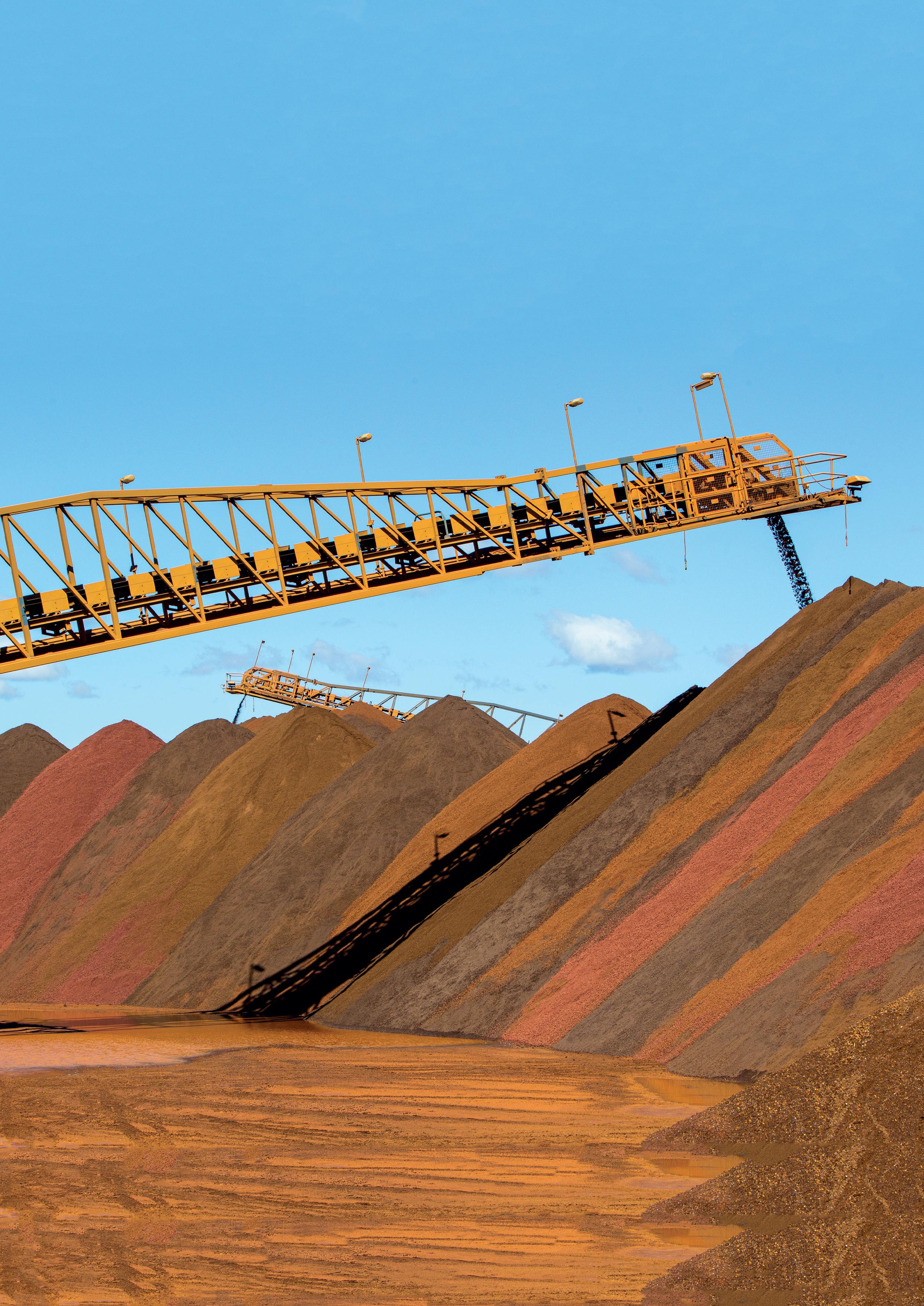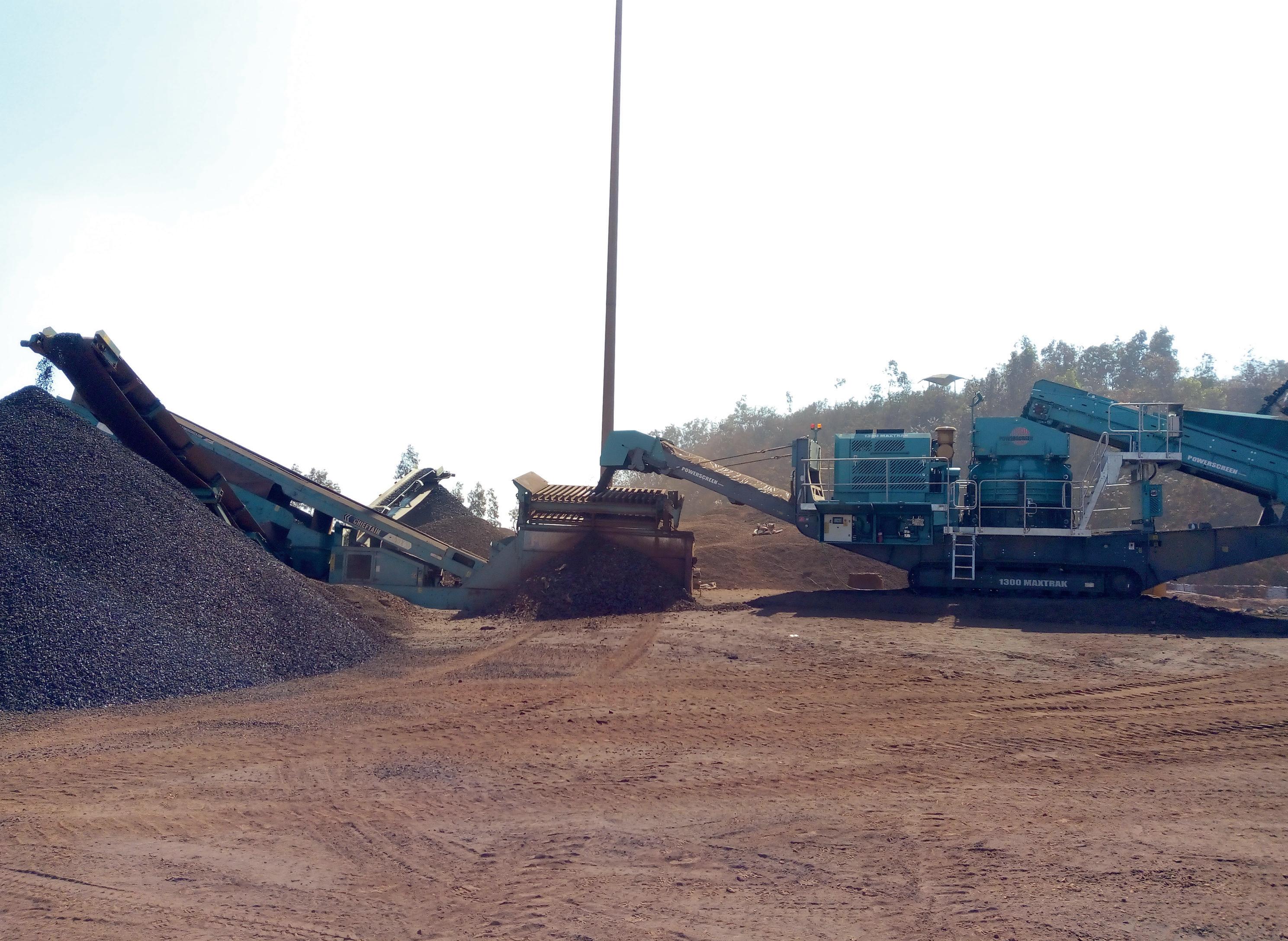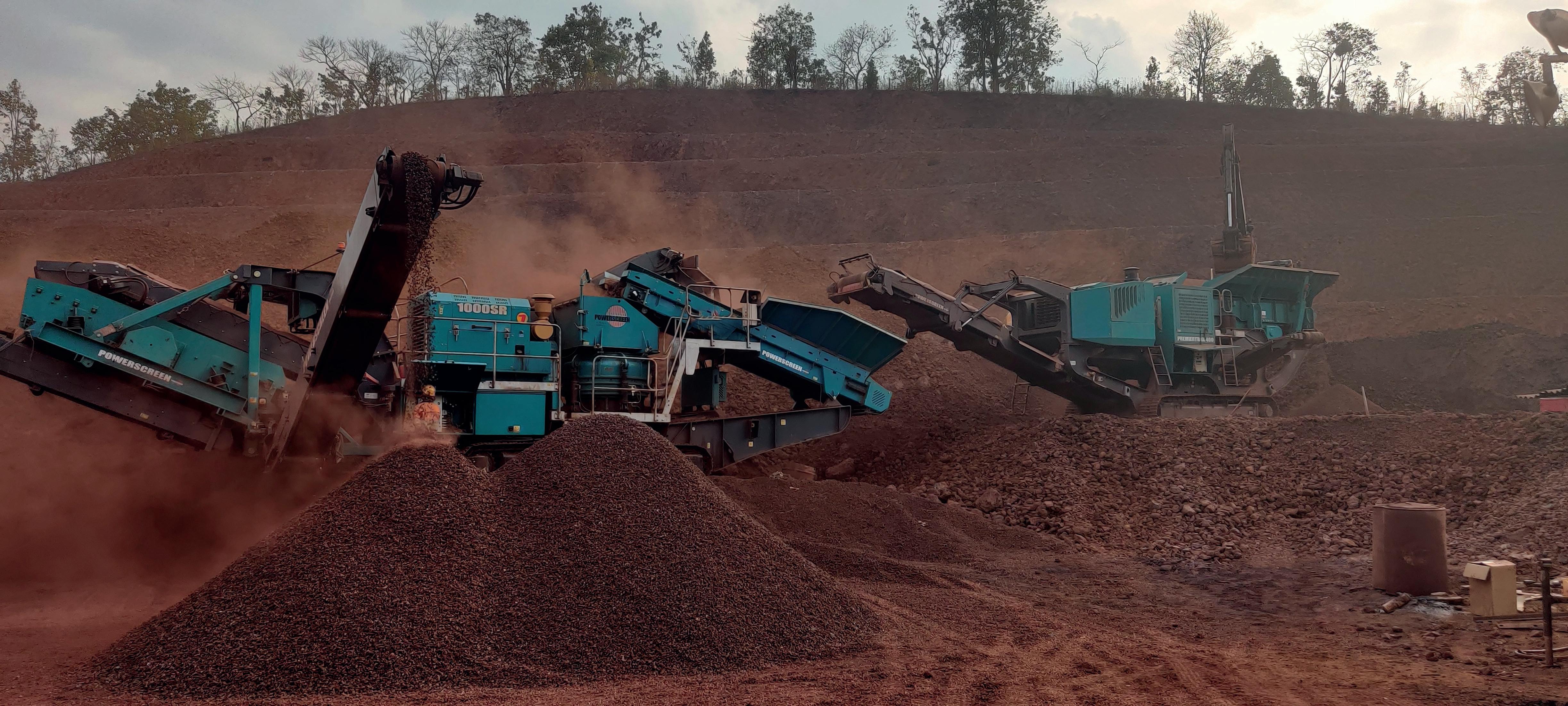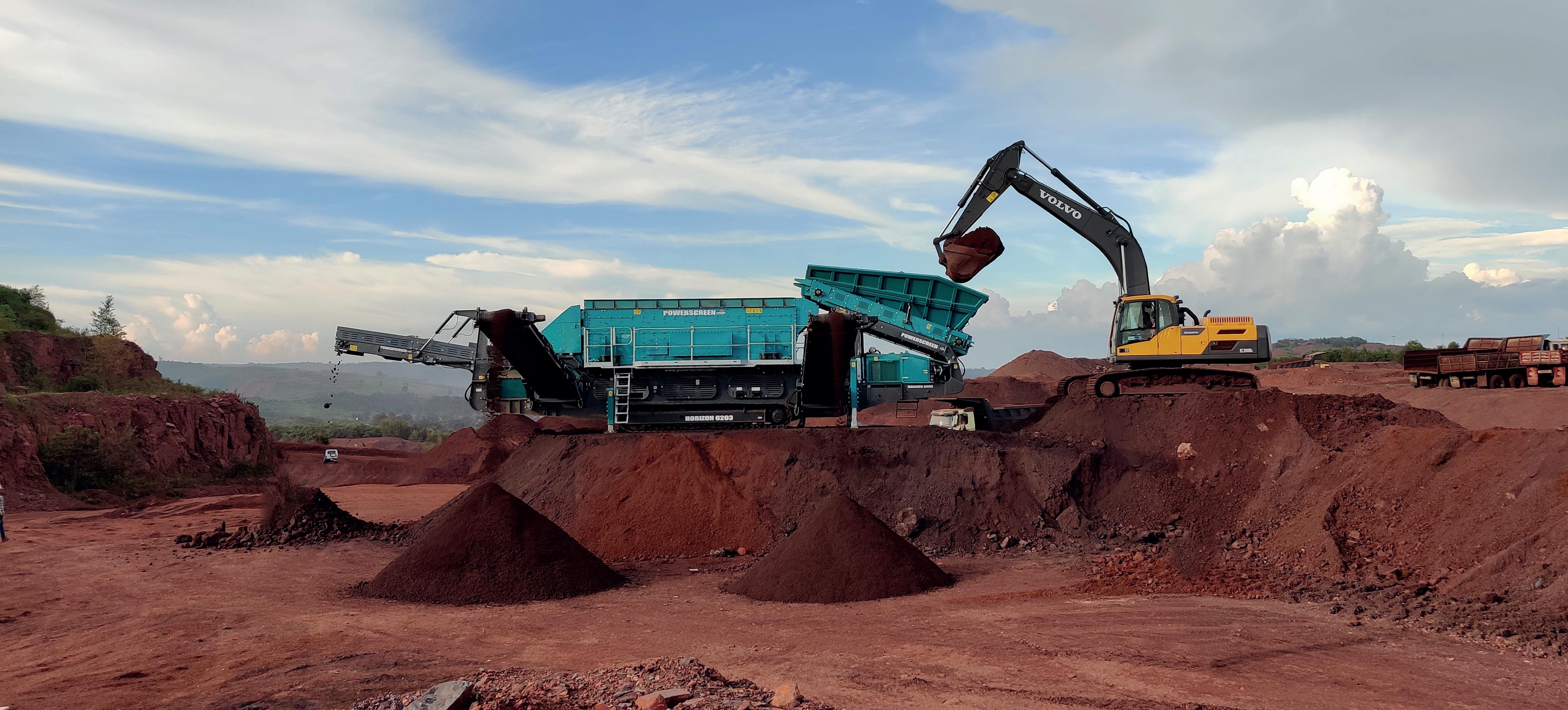
7 minute read
Crushing And Screening Challenges For The Mining Industry
Mohit Kumar, Terex, India, considers some solutions to the most significant crushing and screening challenges faced by the mining industry today – with a particular focus on iron ore mining in India.
One of the main challenges faced by the mining industry in terms of crushing and screening includes the feed material itself, which often has a high moisture content and therefore requires an aggressive screening box design. It also encounters a high quantity of fines (approximately 40 – 50%), which means equipment should have a large screening area and various screen media options to address this. Additionally, precise end-product specifications are required, such as 5 – 18 mm or 10 – 30 mm, that can be used as iron ore lumps in the blast furnace or for direct reduced iron (DRI) steel processing. Given the huge scale of mining sites, equipment must be transported regularly, which gives mobile crushing and screening machines a competitive advantage over static plants.
Iron ore mining in India
India is a mineral rich country which produces approximately 89 different minerals. Mining is one of the key industries required for the country’s infrastructure development and significantly contributes to the growth of the Indian economy. While the mining sector had to bear the brunt of the pandemic-induced lockdown in 2020, India has registered robust growth in the last few months in comparison to previous years. This is primarily due to increased local steel demand and the auctions of iron ore in the recent years. There is also a significant scope for new mining capacities in coal, bauxite, and other minerals.
Iron and steel make up a core component of the infrastructure sector. Infrastructure projects continue to provide lucrative business opportunities for steel, zinc, and aluminium producers. Demand for these metals is set to continue, given the growth expectations for the residential and commercial building industries. According to ICRA Ltd, overall construction equipment demand has grown multi-fold in 2021 and is poised to grow by 15 – 20%.
In India, there are a few major iron ore mining blocks that have a vast number of mining sites. The first one is around Barbil – a city and municipality in the Kendujhar district of the state of Odisha. The region around Barbil has one of the largest deposits of iron ore in the world. The other major iron ore mining area is around Hospet – a city and district headquarters of the Vijayanagara district, in the state of Karnataka. Iron ore produced in these areas tends to go to either blast furnace or DRI steel plants, where it is used in sinter and palletisation units to prepare it for steel production. The iron ore here is mostly consumed domestically by India itself, but is also exported to other countries across the Middle East and Asia.
Indian iron ore mining companies and their subcontractors form one of the largest buyers of machines for Powerscreen, which is manufactured and supported by the service team of Terex India, as well as local Powerscreen dealers. They have substantial experience in the mining sector and pride themselves in moving in a direction of sustainability.
Operations in India

Terex commenced operations in India back in 2009, and now, more than a decade later, enjoys a strong market presence through various brands, such as: Powerscreen, Terex Finlay, Terex Minerals Processing Systems, and Terex Washing Systems.
Through extensive product innovation, the facility’s operations have grown multi-fold in the last 12 years, starting from four models in 2009, to more than 60 models in 2021. Terex India is also developing state-of-the-art larger capacity machines, which will further increase its capability to cater for the ever-growing demand of the mining sector, while also exporting these to other parts of the world.
Crushing and screening plant set up
Figure 1. Chieftain 2200 working in iron ore.
Most of Terex India’s customers typically have Powerscreen equipment in operation across the mining belts of India. The equipment set up includes the Powerscreen Chieftain range of inclined screens, which are used to segregate ROM iron ore, producing a variety of 0 – 10 mm, 10 – 40 mm, and 40+ mm products. This initial screening of the iron ore separates fine particles from the product before it enters the crushing stage, which prevents overloading of the crusher and increases its productivity. The Chieftain models are particularly suitable as they support applications where high volumes of finished products are required – with benefits including: quick set-up times, drop down tail conveyor, screen mesh access system to aid screen media changes, and a transverse power unit to simplify servicing. The versatility of the Chieftain offers improved capabilities, particularly in sticky scalping applications that are often encountered in Figure 2. Powerscreen Premiertrak 400 jaw crusher and 1000SR cone crusher. iron ore mining.

From here, a crushing train – consisting of a jaw crusher (such as the Premiertrak 400X), cone crusher (such as the 1000 Maxtrak, 1000SR, and 1300 Maxtrak), and inclined screen – is used to produce 0 – 10 and 10 – 40 mm end products, and later for steel production.
Jaw crushers are typically used as the primary crusher because they can take large and variable sizes of feed material, meaning the original feed will not have to be blasted down to a fine size. Powerscreen jaw crushers are designed to be significantly more reliable and have lower wear rates, maximising production and minimising wear parts.
Powerscreen cone crushers, meanwhile, are highly effective at using compression to crush material into a consistent product. For this reason, cone crushers are the most commonly used crushing plant for secondary and tertiary crushing stages. When used correctly, they will have lower operating costs than an impactor and will produce less fines. The Powerscreen range of mobile cone crushers uses advanced Automax® crusher technology, in order to provide high volumes of quality end product.
As Powerscreen equipment is mobile, it is moved to crush the material on the bench of the mine itself. This saves customers time and money, with production typically starting within a couple of hours from delivery. Additionally, Powerscreen provides different types of screening media – such as punch plate, woven wire mesh, and welded wire mesh – to handle the difficult feed material.
Supporting the industry’s drive towards sustainable mining, Powerscreen has evolved its product range to reduce environmental impact by making its crushing and screening equipment as fuel efficient as possible. Recent developments include using direct drive systems for its crushing range, improving engine capabilities, and a drive-line design for its screening range.
Another important tool for fuel efficiency is Powerscreen Pulse™ telematics – which helps customers see how and where their machines are being operated, understand fuel consumption, and carry out fault-finding activities to ensure optimal performance. Powerscreen Pulse has recently been launched for products manufactured at the Terex facility in Hosur, meaning that customers in India can now avail of actionable information with customised reports and suggested actions for more fuel-efficient operations.
Terex India is also preparing to launch Powerscreen Hybrid and dual powered machines, which will further help the reduction of fuel consumption.
Supporting mining customers in India
Along with Powerscreen dealers, Terex has made significant investment to expand its aftermarket footprint across India. Service experts are located throughout the country to be closer to customers and ensure that their needs are being met. Additionally, Terex has spare parts warehouses strategically located across the country, so that parts are delivered quickly – including shipments to remote mining sites.
Another major challenge for the mining industry in India is the lack of skilled and trained personnel to operate crushing and screening equipment. Terex India has been working closely with its customers to ensure the availability of skilled technicians, who are experienced with operating crushing and screening equipment in a safe and efficient manner. A dedicated training centre at the Terex Hosur facility provides advanced training to crusher operators and plant supervisors. This is accredited as a training partner of the Infrastructure Equipment Skill Council (IESC), under Skill India and the NSDC programme of the government of India.
Additionally, a large team of design engineers based at Terex Hosur, and also at the Terex Global research and development centre in Bangalore, constantly work on new models suited for the Indian mining requirements.
Finally, Terex India has also evolved and adapted its service offering to meet the needs of its mining customers during the COVID-19 pandemic, when travel restrictions and local lockdowns made it difficult for service experts to travel. This includes leveraging digital solutions to engage with customers and provide support through webinars and other online events.
Future of crushing and screening for the mining industry in India
Figure 3. Powerscreen Horizon H6203. India is witnessing rapid urbanisation, fuelling demand for faster construction – which is a major driver for customers to move towards mobility in their crushing and screening equipment. The demand for hybrid plants will also grow, as well as the need for higher capacity plants in the future for the mining sector. The coal sector is also set to grow rapidly over the next few years, so while Powerscreen already have a range of equipment which customers are currently using in their coal mines, new products that further meets the demands of this sector will be launched in the future.











